Tell Arbid (Syria)
SEEKING POST-AKKADIAN TELL ARBID
THE POLISH-SYRIAN MISSION TO TELL ARBID (Poznań University Project), SPRING 2009
Dates: 9 May – 25 June 2009
Team:
Dr. Rafał Koliński – field director, archaeologist (Institute of Prehistory, Adam Mickiewicz University, Poznań)
Jowan Kassim – co-director, archaeologist (Regional Direction of Antiquities and Museums, Qamishli)
Michał Krueger – archaeologist (Institute of Prehistory, Adam Mickiewicz University, Poznań)
Sa’ud al-Hussein, Fahad Hussein – archaeologists (Regional Direction of Antiquities and Museums, Qamishli)
Xenia Kolińska – archaeologist, documentalist
Dr. Łukasz Rutkowski – archaeologist (Polish Centre of Mediterranean Archaeology, University of Warsaw, Poland)
Iwona Barczyńska, Michał Lawer, Joanna Mardas, Agata Smilgin, Adam Szczęsny, Marika Święszkowska – archaeology students (Institute of Prehistory, Adam Mickiewicz University, Poznań)
Acknowledgments:
The work was sponsored by a research grant from the Polish Ministry of Science, no. N 109 3983 33, and supported by the Foundation for Polish Science, the Adam Mickiewicz University, the Foundation of the Adam Mickiewicz University, Polkomtel S.A. and private sponsors.
The program of the second season of the project “Collapse, regress or progress. The settlement and cultural landscape of the Syrian Jezirah at the end of the Early Bronze Age” concentrated on exploring two Khabur Ware period (1800-1700 BC) cemeteries identified during the previous season and extensive clearance of a post-Akkadian building found last year. Remains of the Akkadian period (2350-2150 BC) have also been exposed.
More than a dozen Khabur Ware period graves were explored during the season. They are part of three small cemeteries surrounding a cluster of houses. The northern one located northwest of House I comprised two chamber graves (one of them, G2 had been explored in 2008, the other, G1, now). West of House II, there were mainly cist graves (at least seven identified), but also two child graves in pots. The third cemetery lies under a courtyard located between Houses I, II, III and IV, and partly under a one-room structure belonging to a later phase of the Khabur Ware period settlement, in the southeastern part of the sector. In this area, a chamber grave (G7), five pot graves and two pit inhumations were discovered.
The chamber graves turned out to be of particular interest because of certain architectural features, as well as important clues for reconstructing funerary rituals. The graves were very similar in structure. A mud-brick chamber of internal dimensions c. 2 by 1 m and provided with a vaulted roof was constructed at the bottom of a large pit, reaching up to 2.50 m in depth.
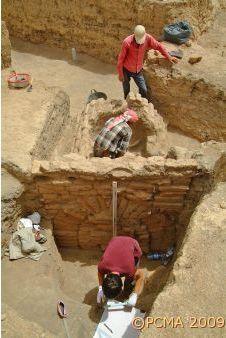
The pit over the chamber was then filled with earth, leaving free only a shaft to a doorway leading to the burial chamber. This shaft was provided with a casing wall rising above the doorway in order to prevent loose earth from descending into the shaft. This wall may have reached the ground surface at the time, marking in this way the position of the grave. This would have been important in the case of subsequent burials. After the burial the doorway was blocked with bricks and the shaft filled with earth. Whenever a new body was introduced, remnants of the previous burial were pushed deeper into the chamber to make space. The most recent burial is always in anatomical position, showing a contracted position with the back along the chamber wall and the head toward the back of the chamber. The grave inventory usually included two Khabur Ware pots, a bronze pin and, occasionally, beads.
One of the graves (G7) bears traces of ritual activities in the shaft of the grave, too. There was a child burial placed in the northern corner of the shaft and, higher in the fill, two complete jugs of plain ware, a dog skeleton and a number of animal bones. These last items were either offerings or remnants of a funerary banquet, or both.
Grave G7 was used for a long period of time, as indicated by the fact that at least six adult persons were buried there. It provided a rich collection of burial gifts, including an elaborate bronze shaft-hole axe, three bronze daggers or spearheads, a bronze bracelet, bronze pincers, a number of other ornamental bronze items, six pots, among these a burnished Grey Ware bowl, and more than 200 beads, of lapis lazuli, carnelian and agate among others.
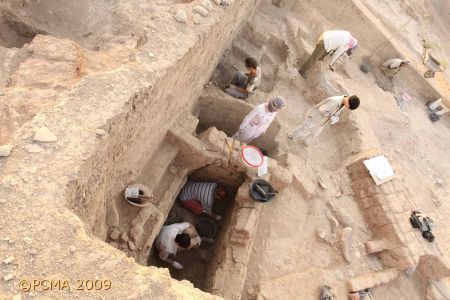
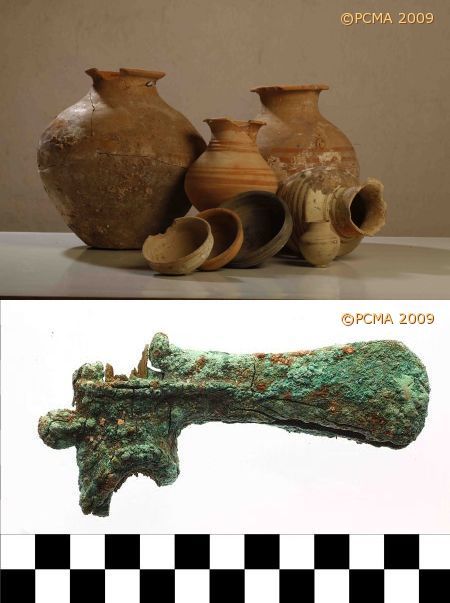
Cist graves show very little variation. They usually accommodated a single skeleton of an adult person, accompanied by one pottery vessel and a bronze pin.
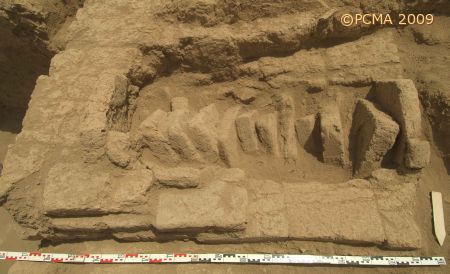
Child graves in pottery vessels show much more variability. Some of them were located inside the houses, under the floors; they usually belonged to infants and did not contain any burial gifts. Older children were buried in the cemeteries, usually deposited in large but damaged pottery vessels. Some of these graves tend to be relatively rich: for instance grave G4 in square 36/62 contained 12 pottery vessels and grave G6 in square 37/62 two bronze bracelets, an exceptional find for the Khabur Ware period at Tell Arbid.
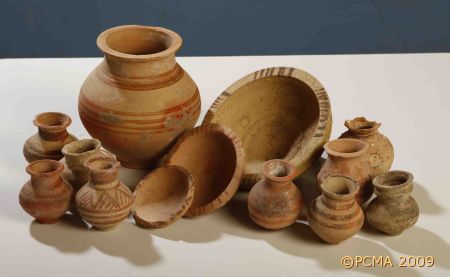
Remains of the post-Akkadian period were excavated in the southern and central parts of the sector. In the so-called Residence, three chambers were completely cleared: L.13 — a spacious, almost square room (5 by 5 m) entered from a paved courtyard (L.9) leading to two smaller chambers adjoining it on the west: L. 10 and L. 24. The walls, preserved up to 1.75 m in places, were covered with a thick layer of red mud plaster, witnessing repeated coatings over a considerable period of time. Locus 24, small in size and with only one entrance, was probably a storeroom. A number of bronze fragments were found on the floor, including a complete bronze sickle, 24 cm long. The sickle has a star sign etched on the blade; in Mesopotamian cuneiform script this sign designates a “god”.
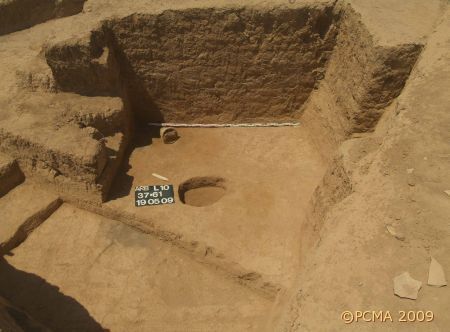
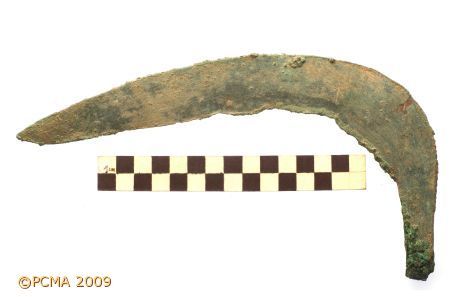
The building, however, does not seem to be a temple. Two large basalt querns and a mortar of the same material were discovered on the floor of the main room as well as a few complete clay vessels and numerous pottery sherds which suggests a domestic use of the space. The building continues eastward (where a fragment of a room belonging to the eastern wing and an entrance to it were discovered) and, most probably, also northward.
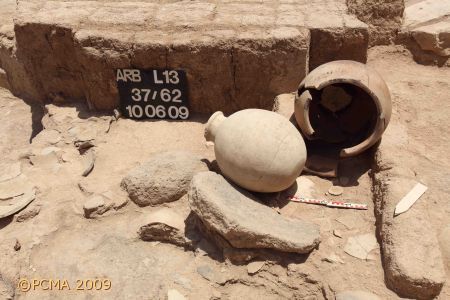
To the west, several smaller structures were cleared, some of them built against the western wall of the already described Residence. Interesting finds came from Locus 33, where another bronze sickle and three bronze pins were found, together with a sandstone mould for casting bronzes. The area between the structures was either used for communication or for household activities, and for this reason a primitive drainage system was constructed there. Open channels made of stones and sherds drained water from the area and in two places ceramic pipes were discovered. Locus 17, where the floor was paved with stones and potsherds, yielded some noteworthy finds, including a fragmentary gold bead, a kohl-pin of bronze, and some scrap bronze fragments forgotten among the stones.
The area to the south of the buildings was an open space with some small-scale structures, like a large bread oven for example. All of the identified post-Akkadian graves were located in this area as well. Two of them are worth mentioning because of the burial gifts discovered inside them. G9/38/61 is a pot burial. A small child (about three years old) was provided with two bronze bracelets and a number of beads including seven marine shells, three frit bird-beads, and two stone pendants, one of which was made of a broken prehistoric stamp seal.
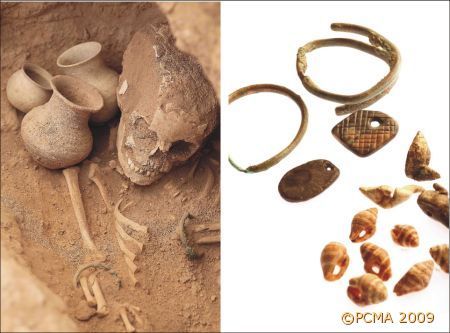
The other grave (G12/38/61) contained the skeleton of a child 8-10 years of age. The body was deposited in a pit together with three pottery vessels placed by the head and a set of bronzes including two bracelets on the forearms, a ring on the finger and a crescent-shaped pendant found under the jaw.
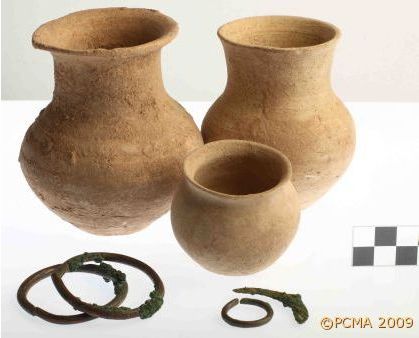
Akkadian architectural remains discovered on the same level as post-Akkadian structures suggest a steady rise of the slope west of this area. Earlier deposits were identified further west of this area in 2008. A few meters to the north, the earlier layers were considerably disturbed by a deep pit dug in post-Akkadian times and filled with midden deposits containing much ash. These deposits were dated by numerous finds of post-Akkadian pottery, as well as animal and human figurines. A pisé wall was erected to separate the pit from the settlement.
[Text: R. Koliński]
